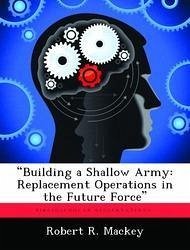The United States Army has spent substantial resources and effort developing a cohesive plan for adapting to the changing world environment of the twenty-first century, commonly called 'transformation.' The Army has experimented and fielded new weapons systems, tested new organizational structures and evaluated radical tactical doctrines to meet the challenges of the future. However, one critical facet has been relatively ignored, the ability to replace personnel losses in the Future Army. The Interim and Objective Forces both lack a workable system to replace combat losses, especially in a high-casualty producing conflict, such as urban operations or a war against a similarly equipped foe. While the organizations themselves are designed to outfight enemies with a combination of precision firepower and mobility, the simple fact remains that war causes casualties. Historical examples from the 1973 Arab-Israeli War and the 1995 Russian-Chechen conflict, along with statistical studies, all demonstrate that warfare throughout the ages is a costly business, and that no evidence exists that future conflict will be bloodless. Sadly, the personnel replacement system in no way can support the 96-hour deployment concept of the Future Army. The present personnel system is a relic of World War II and the Cold War, meant to operate only when given ample warning time to mobilize and prepare. At its best, the present system produces replacements weeks after mobilization, while the Selective Service System takes nearly a year to train the first conscript. The U.S. Army's Reserve system is not much better, handicapped by the fact that the units responsible for mobilization of replacements require mobilization themselves. The result could be catastrophic as rapidly deploying units fight to exhaustion before the first replacements arrive. Several solutions exist that could remedy this situation.








